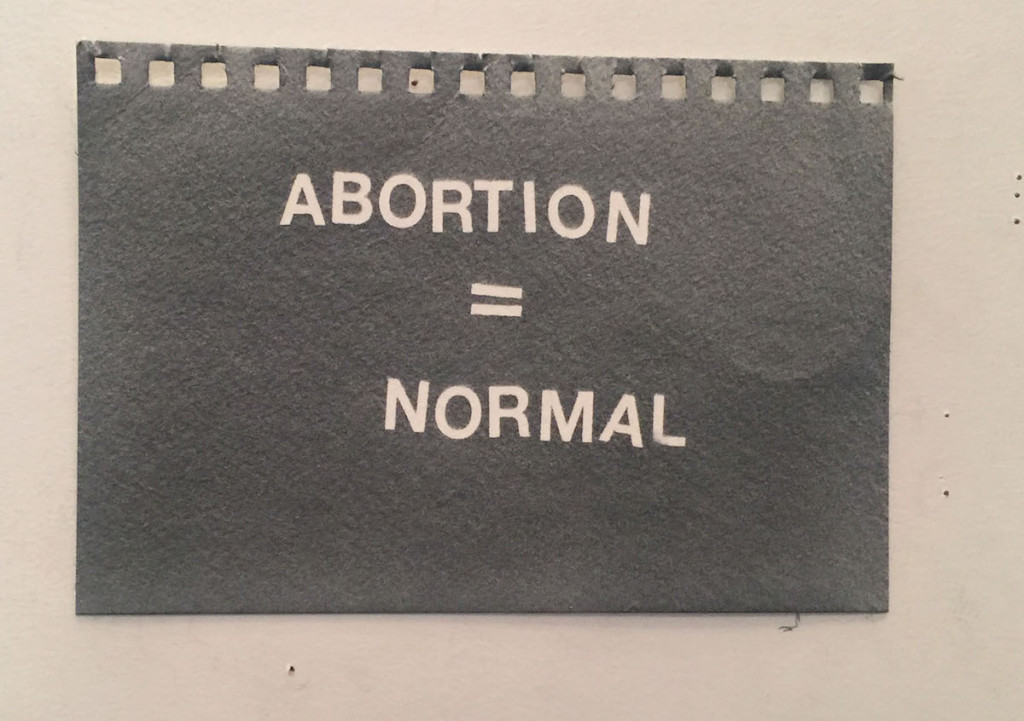[ad_1]
On May 15, 2019, Alabama governor Kay Ivey signed into law the Human Life Protection Act, through which doctors who perform abortions in the state could potentially be sentenced to life in prison. It provides exceptions only “to avoid a serious health risk to the unborn child’s mother” and if the “unborn child has a lethal anomaly.” Ivey said in her statement at the time that the bill “may bring about the best opportunity” to challenge to Roe v. Wade in the Supreme Court.
That same day, Jasmine Wahi, the curator, activist, and founder and co-director behind Project for Empty Space in Newark, New Jersey, wrote to the artist Marilyn Minter. Wahi was thinking about organizing an exhibition around reproductive justice, and Minter was all for it. “Let’s do something. I’m going batshit crazy,” the artist replied to Wahi.
What resulted from that correspondence is the exhibition “Abortion Is Normal,” co-curated by Wahi and Rebecca Pauline Jampol, a curator and designer who directs Project for Empty Space with her. Minter; Gina Nanni, a founding partner of the public relations enterprise Company Agenda; artist Laurie Simmons; and art historian Sandy Tait were brought on to help organize the show, which first opened at Project for Empty Space in 2019 and makes its two-venue New York debut today.

Courtesy the artist and Downtown for Democracy
“Our sentiment is that abortion is part of health and reproductive justice, and anything having to do with reproductive justice has to do with body autonomy and body sovereignty,” Wahi told ARTnews. “Therefore any type of medical procedure—anything that affects one’s body—that is their choice to do should be normal.” The show’s title, she said, speaks to the idea that “what you do with your body should be your choice and whatever that entails should be something that we consider normalized.”
“It’s really making you think about [abortion] as something that’s part of our healthcare that’s supposed to be normalized, and that we’re supposed to have this access. It shouldn’t be a fight for it,” Jampol added.
The first segment of the show opens on Thursday at Galerie Eva Presenhuber, and the second part will be on view at Arsenal Contemporary starting January 21. Works by some 50 artists—including marquee names like Alison Janae Hamilton, Barbara Kruger, Betty Tompkins, Catherine Opie, Cindy Sherman, Hank Willis Thomas, Louise Lawler, Lyle Ashton Harris, Mika Rottenberg, Nan Goldin, Shirin Neshat, and Wangechi Mutu—will be exhibited across the two locations. All proceeds from works sold will go to the group Downtown for Democracy, which will distribute half of the proceeds to fund voter education and advocacy efforts focused on reproductive rights and the other half of the funds to Planned Parenthood PAC efforts during the 2020 U.S. Presidential elections.
One of the priorities for Wahi and Jampol in putting the show together was to present a diversity of perspectives and approaches to the topic of reproductive justice—which meant that not every artist they considered specifically focused on abortion in their work. Instead, they strove to find artists whose work could speak to “a larger idea of body ownership and autonomy,” as Wahi put it. ELEKTRA KB’s work, for instance, explores conversations around queerness and reproductive health. An installation featuring photographs taken in a hospital in the town where ELEKTRA KB grew up will be in the show. Also on view is Dominique Duroseau’s digital C-print, titled Mammy was here, She Equally Acceptable (2019), which depicts an individual in six different poses and deals with issues of access, the curators said.

Courtesy the artist and Downtown for Democracy
“There’s a real spectrum of conversations that are taking place, but they all come to this point about where we are in this moment,” Jampol said.
Some works in the show tackle abortion head-on, however, often with nods to feminist struggles of years past. In the exhibition are performance ephemera by Viva Ruiz/Thank God For Abortion, an installation of perfume bottles containing menstrual blood by Christen Clifford, and a new work by Jon Kessler incorporating a hanging and an iPad on which archival footage from abortion clinic bombings of the 1970s. Minter’s contribution to the exhibition is a new print from her series “CUNTROL,” and Simmons gave the show a 1971 work from one of her photographic series featuring dolls, which she has used in her work to explore issues related to gender and sexuality.
“I think what’s really spectacular for us is to have work that continues this important dialogue,” Wahi said, noting that Kessler’s works points to the “cyclical moment we’re in.”
Could works such as Kessler’s raise consciousness among its visitors? Only time will tell, but Wahi and Jampol seem confident that they might. “I hope this is the beginning of a much larger dialogue,” Wahi said. “I hope that other people see what both Rebecca and I believe in very strongly, which is how impactful art can be in shaping social cause and making a difference.”
[ad_2]
Source link

